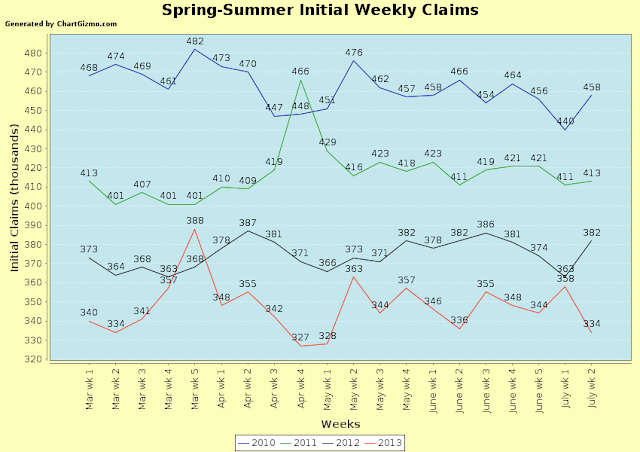ADP report shows that private businesses added 200,000 jobs in July. Businesses of all sizes added to job growth.
ADP job numbers for July 2013 show continued increasingly robust private-sector job growth as private employers add 200,000 jobs.
The monthly jobs report from the payroll processor ADP is usually seen as a bellweather of the national jobs report from the Bureau of Labor Statistics that is released a couple of days later. This morning's ADP report seems to indicate that the private sector, despite tax increases and the sequester, continued to add jobs, this month, a significant number of jobs, for the 41st consecutive month. The turnaround started in February 2010.
ADP's numbers are based on their own payroll transactions, "Bureau of Labor Statistics employment data, and the Philadelphia Federal Reserve Bank’s AruobaDiebold-Scotti Business Conditions Index. The sample size of the ADP data set (is derived from data) which accounts for more than 20 percent of all U.S. private sector employees."
BLS Jobs Numbers and Unemployment Rate To Be Released Friday, August 2nd.
Bureau of Labor Statistics employment reports are not released until Friday, so we will have to wait until then (August 2nd) to see if the BLS agrees.
Last month, ADP claimed 188,000 new private sector jobs (revised upwards to 198,000 new private sector jobs this month) while the BLS estimated that 202,000 private sector jobs were added. ADP estimated that 992,000 private sector jobs were added in the first six months of 2013 (through June), while the BLS estimated that 1,234,000 private sector jobs were added in those same first six months.
ADP writes:
ADP's numbers are based on their own payroll transactions, "Bureau of Labor Statistics employment data, and the Philadelphia Federal Reserve Bank’s AruobaDiebold-Scotti Business Conditions Index. The sample size of the ADP data set (is derived from data) which accounts for more than 20 percent of all U.S. private sector employees."
BLS Jobs Numbers and Unemployment Rate To Be Released Friday, August 2nd.
Bureau of Labor Statistics employment reports are not released until Friday, so we will have to wait until then (August 2nd) to see if the BLS agrees.
Last month, ADP claimed 188,000 new private sector jobs (revised upwards to 198,000 new private sector jobs this month) while the BLS estimated that 202,000 private sector jobs were added. ADP estimated that 992,000 private sector jobs were added in the first six months of 2013 (through June), while the BLS estimated that 1,234,000 private sector jobs were added in those same first six months.
ADP writes:
Private-sector employment increased by 200,000 from June to July, on a seasonally adjusted basis... June’s job gain was revised upward from 188,000 to 198,000.
Highlights:
- Small businesses (1-49 employees) +82,000
- Medium businesses (50-499 employees) +60,000
- Large businesses (500 or more employees) +57,000
The ADP report also shows that most job growth occurred in the service-providing sector which added 177,000 out of the 200,000 jobs last month. The goods producing segment was estimated to have increased by 22,000 jobs. Construction increased by 22,000 and manufacturing decreased by 5,000.
ADP also puts out a small business report, detailing the job gains in businesses with under 50 employees. You can find it HERE.
ADP also puts out a small business report, detailing the job gains in businesses with under 50 employees. You can find it HERE.
Mark Zandi, chief economist of Moody’s Analytics, is quoted in the ADP report:
Job growth remains remarkably stable. Businesses are adding to payrolls in most industries and across all company sizes. The job market has admirably weathered the fiscal headwinds, tax increases and government spending cuts. This bodes well for the next year when those headwinds are set to fade.
When attempting to make any sense of this ADP report, here are a few things to consider:
- This is an estimate based mostly on ADP's survey of its payroll processing private-sector clients. Over time, it moves in parallel with the government's BLS Establishment numbers, but it is not perfectly in synch with the government's numbers. Also, the government reports may be more accurate in tallying small startups which may not be using a payroll processing service. The ADP numbers usually run about 300,000 to 600,000 lower than the BLS private jobs numbers in total jobs, not in increases or decreases of jobs.
- To reiterate what I've mentioned in previous months, the stock market moves up or down not in concert with any reports of job growth (we haven't had any decline in total private jobs in three years.), but in concert with reports of job growth compared to what the pundits THINK the reports should say.
- Headlines are often sensational and sometimes absurd.



